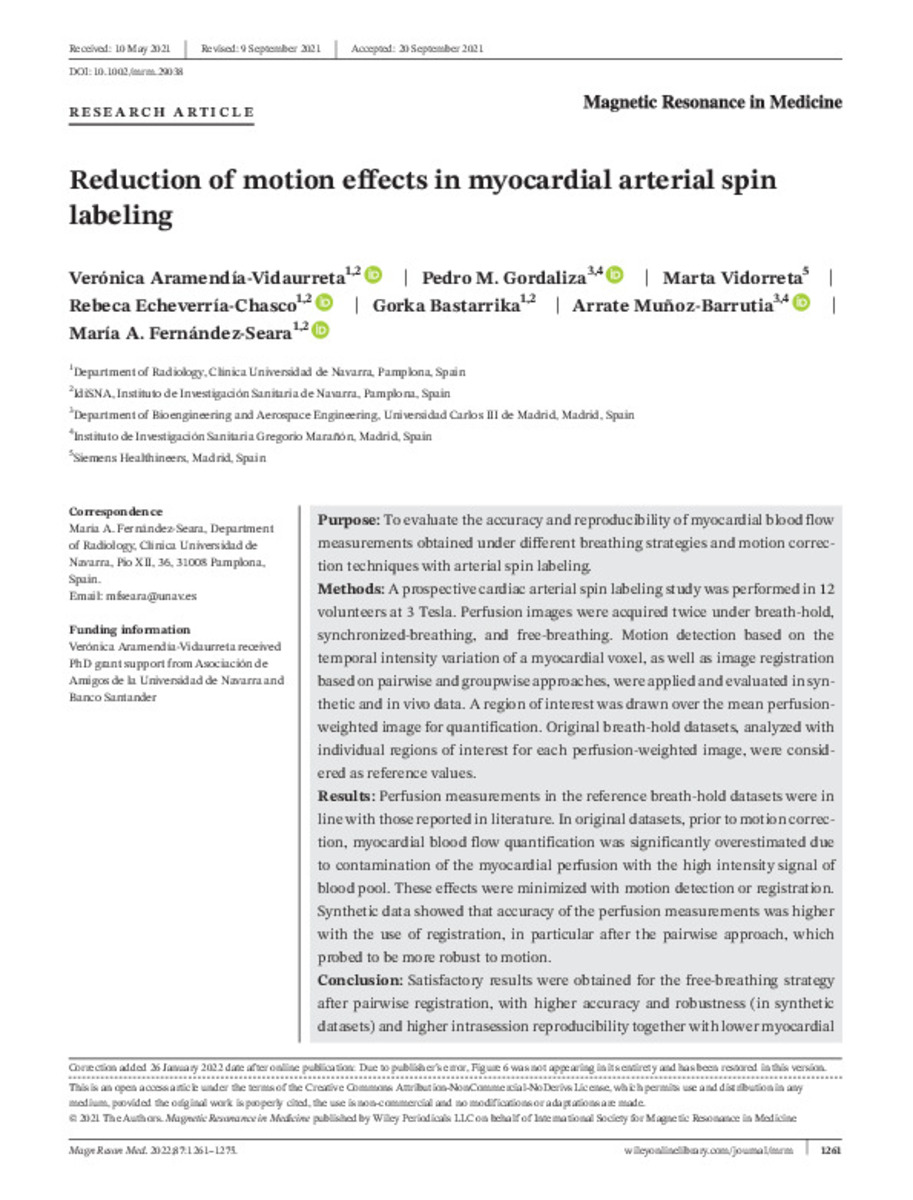Registro completo de metadatos
| Campo DC | Valor | Lengua/Idioma |
|---|---|---|
| dc.creator | Aramendía-Vidaurreta, V. (Verónica) | - |
| dc.creator | Gordaliza, P.M. (Pedro) | - |
| dc.creator | Vidorreta, M. (Marta) | - |
| dc.creator | Echeverría-Chasco, R. (Rebeca) | - |
| dc.creator | Bastarrika, G. (Gorka) | - |
| dc.creator | Muñoz-Barrutia, A. (Arrate) | - |
| dc.creator | Fernández-Seara, M.A. (María A.) | - |
| dc.date.accessioned | 2022-03-29T11:54:22Z | - |
| dc.date.available | 2022-03-29T11:54:22Z | - |
| dc.date.issued | 2021 | - |
| dc.identifier.citation | Aramendía-Vidaurreta, V. (Verónica); Gordaliza, P.M. (Pedro); Vidorreta, M. (Marta); et al. "Reduction of motion effects in myocardial arterial spin labeling". Magnetic Resonance in Medicine. 87 (3), 2021, 1261 - 1275 | es_ES |
| dc.identifier.uri | https://hdl.handle.net/10171/63299 | - |
| dc.description.abstract | Purpose To evaluate the accuracy and reproducibility of myocardial blood flow measurements obtained under different breathing strategies and motion correction techniques with arterial spin labeling. Methods A prospective cardiac arterial spin labeling study was performed in 12 volunteers at 3 Tesla. Perfusion images were acquired twice under breath-hold, synchronized-breathing, and free-breathing. Motion detection based on the temporal intensity variation of a myocardial voxel, as well as image registration based on pairwise and groupwise approaches, were applied and evaluated in synthetic and in vivo data. A region of interest was drawn over the mean perfusion-weighted image for quantification. Original breath-hold datasets, analyzed with individual regions of interest for each perfusion-weighted image, were considered as reference values. Results Perfusion measurements in the reference breath-hold datasets were in line with those reported in literature. In original datasets, prior to motion correction, myocardial blood flow quantification was significantly overestimated due to contamination of the myocardial perfusion with the high intensity signal of blood pool. These effects were minimized with motion detection or registration. Synthetic data showed that accuracy of the perfusion measurements was higher with the use of registration, in particular after the pairwise approach, which probed to be more robust to motion. Conclusion Satisfactory results were obtained for the free-breathing strategy after pairwise registration, with higher accuracy and robustness (in synthetic datasets) and higher intrasession reproducibility together with lower myocardial blood flow variability across subjects (in in vivo datasets). Breath-hold and synchronized-breathing after motion correction provided similar results, but these breathing strategies can be difficult to perform by patients. | es_ES |
| dc.description.sponsorship | Verónica Aramendía- Vidaurreta received PhD grant sup-port from Asociación de Amigos de la Universidad de Navarra and Banco Santander. | es_ES |
| dc.language.iso | eng | es_ES |
| dc.publisher | Wiley | es_ES |
| dc.rights | info:eu-repo/semantics/openAccess | es_ES |
| dc.subject | Arterial spin labeling | es_ES |
| dc.subject | Coronary artery disease | es_ES |
| dc.subject | Motion correction | es_ES |
| dc.subject | Myocardial blood flow | es_ES |
| dc.subject | Myocardial perfusion | es_ES |
| dc.title | Reduction of motion effects in myocardial arterial spin labeling | es_ES |
| dc.type | info:eu-repo/semantics/article | es_ES |
| dc.identifier.doi | 10.1002/mrm.29038 | - |
| dadun.citation.endingPage | 1275 | es_ES |
| dadun.citation.number | 3 | es_ES |
| dadun.citation.publicationName | Magnetic Resonance in Medicine | es_ES |
| dadun.citation.startingPage | 1261 | es_ES |
| dadun.citation.volume | 87 | es_ES |
Ficheros en este ítem:
Estadísticas e impacto
Los ítems de Dadun están protegidos por copyright, con todos los derechos reservados, a menos que se indique lo contrario.






